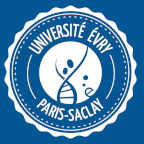IBISC (Informatique, BioInformatique, Systèmes Complexes) EA 4526 est le laboratoire STIC de l’Université de Paris Saclay – Université d’Evry, assurant une visibilité dans ce domaine sur le site, répondant aux enjeux du numérique et de l’interdisciplinarité, notamment en Génomique. Il est issu de la fusion de deux laboratoires : le LAMI (UMR 8042) et le LSC (FRE 2494). La gouvernance du laboratoire est assurée par la direction composée d’un directeur, Nazim AGOULMINE, et d’une directrice adjointe, Lydie NOUVELIERE.
Le laboratoire IBISC se compose de 4 équipes (AROB@S, COSMO, IRA2, SIAM) dont les activités se répartissent en deux axes scientifiques STIC & SMART SYSTEM et STIC & VIVANT. Sans couvrir toutes les activités de recherche en leur sein, chacun des axes se focalise sur un domaine applicatif qui est respectivement : Drone & Véhicule, et Médecine personnalisée et de précision.
- STIC & SMART SYSTEM : Les recherches définies dans cet axe traitent de la conception de systèmes autonomes et intelligents. La notion de système se rapporte à la fois aux flottes de véhicules routiers ou aériens, aux robots, aux logiciels et services distribués et communicants ou aux composants matériels intelligents munis de capteurs interagissant. Ces dispositifs possèdent comme point commun d’être composés d’un grand nombre d’entités en interaction, dotées d’une autonomie de prise de décision tout en coordonnant leurs actions pour réaliser un objectif commun. La conception maitrisée de tels systèmes complexes pose deux questions majeures: l’une relative aux méthodes pour leur conception et l’autre ayant trait à l’optimisation de leur fonctionnement collectif et global, tout en prenant en compte les fluctuations de leur environnement. Elles conduisent à l’exploration de nouvelles approches combinant des méthodes et des théories de différents champs scientifiques : en automatique, algorithmique et méthodes formelles. Les applications se destinent plus particulièrement au domaine Drone et Véhicule.
- STIC & VIVANT : ces recherches interdisciplinaires couvrent un spectre large de problématiques en biologie à différentes échelles du vivant : analyse de données et de signaux biologiques ou biomédicaux, modélisation des systèmes biologiques, apprentissage de gestes chirurgicaux et assistance à la personne. Les recherches portent sur le développement de cadres théoriques, de méthodes algorithmiques et de plateformes répondant à ces enjeux. Concernant l’analyse des données et la biologie des systèmes, elles s’appuient sur des modèles d’apprentissage statistique, sur l’algorithmique pour la prédiction de structure, ainsi que sur la conception de modèles et méthodes formels pour l’analyse de la dynamique des réseaux. Pour l’apprentissage de gestes chirurgicaux et l’assistance robotique à la personne, nous développons des systèmes couplant des techniques d’analyse de signaux issus de plusieurs capteurs et de prise de décision. Les applications se destinent plus particulièrement au domaine de la médecine personnalisée et de précision.



